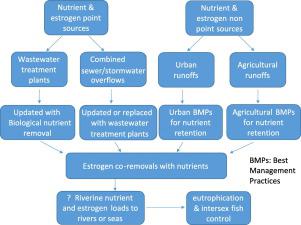Science of the Total Environment ( IF 8.2 ) Pub Date : 2020-12-03 , DOI: 10.1016/j.scitotenv.2020.143904 Shuiwang Duan , Luke R. Iwanowicz , Katia Noguera-Oviedo , Sujay S. Kaushal , Erik J. Rosenfeldt , Diana S. Aga , Sudhir Murthy

|
We evaluate the impacts of different nutrient management strategies on the potential for co-managing estrogens and nutrients in environmental waters of the Potomac watershed of the Chesapeake Bay. These potential co-management approaches represent agricultural and urban runoff, wastewater treatment plant effluent, and combined sewer overflow replacements. Twelve estrogenic compounds and their metabolites were analysed by gas chromatography–mass spectrometry. Estrogenic activity (E2Eq) was measured by in vitro bioassay. We detected estrone E1 (0.05-6.97 ng L-1) and estriol E3 (below detection-8.13 ng L-1) and one conjugated estrogen (estrone-3-sulfate E1-3S; below detection-8.13 ng L-1). E1 was widely distributed and positively correlated with E2Eq, water temperature, and dissolved organic carbon (DOC). Among nonpoint sources, E2Eq, and concentrations of E1, soluble reactive phosphorus (SRP) and total dissolved nitrogen (TDN) decreased by 51-61%, 77-82%, 62-64%, 4-16% in restored urban and agricultural streams with best management practices (BMPs) relative to unrestored streams without BMPs. In a wastewater treatment plant (Blue Plains WWTP), > 94% of E1, E1-3S, E3, E2Eq and TDN were removed while SRP increased by 305% during nitrification/denitrification as a part of advanced wastewater treatment. Consequently, E1 and TDN concentrations in WWTP effluents were comparable or even lower than those observed in the receiving stream or river waters, and the effects of wastewater discharges on downstream E1 and TDN concentrations were minor. Highest E2Eq value and concentrations of E1, E3, and TDN were detected in combined sewer overflow (CSO). This study suggests that WWTP upgrades with biological nutrient removal, CSO management, and certain agricultural and urban BMPs for nutrient controls have the potential to remove estrogens from point and nonpoint sources along with other contaminants in streams and rivers.
中文翻译:

流域营养管理实践有效减少环境水中雌激素的证据
我们评估了切萨皮克湾波托马克流域环境水中不同养分管理策略对共同管理雌激素和养分的潜力的影响。这些潜在的共同管理方法代表了农业和城市径流,废水处理厂的出水以及下水道溢流的联合更换。通过气相色谱-质谱法分析了十二种雌激素化合物及其代谢产物。通过体外生物测定法测量雌激素活性(E2Eq)。我们检测到雌酮E 1(0.05-6.97 ng L -1)和雌三醇E 3(低于检测值8.13 ng L -1)和一种结合的雌激素(雌酮-3-硫酸盐E 1 -3S;低于检测值8.13 ng L-1)。E 1分布广泛,并且与E2Eq,水温和溶解有机碳(DOC)呈正相关。在非点源中,恢复后的城市和农村地区的E2Eq和E 1浓度,可溶性反应性磷(SRP)和总溶解氮(TDN)下降了51-61%,77-82%,62-64%,4-16%。与没有BMP的未经恢复的河流相比,具有最佳管理规范(BMP)的农业流。在废水处理厂(Blue Plains WWTP)中,作为高级废水处理的一部分,在硝化/反硝化过程中,> 94%的E 1,E 1 -3S,E 3,E2Eq和TDN被去除,而SRP增加了305%。因此,E 1污水处理厂废水中的TDN和TDN浓度与接收河流或河水中的浓度相当甚至更低,废水排放对下游E 1和TDN浓度的影响很小。在联合下水道溢流(CSO)中检测到最高的E2Eq值和E1,E3和TDN浓度。这项研究表明,污水处理厂通过生物脱氮,CSO管理以及某些用于控制营养的农业和城市BMP进行升级,具有去除点和非点源雌激素以及溪流和河流中其他污染物的潜力。











































 京公网安备 11010802027423号
京公网安备 11010802027423号